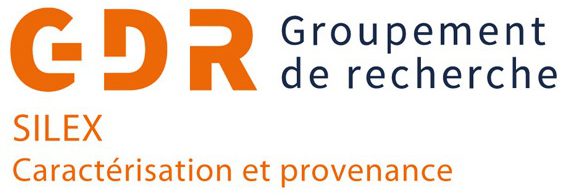Steering committee: Pierre-Antoine Beauvais (post-doc, UMR Traces), Didier Binder (CNRS, UMR Cepam), Françoise Bostyn (University of Paris 1, UMR Trajectories), Jean-Philippe Collin (University of Brussels, UMR Trajectories), Elsa Defranould (post-doc, UMR Traces), Vincent Delvigne (CNRS, UMR Temps), Paul Fernandes (Sarl Paléotime, UMR Temps), Alix Gibaud (INRAP, UMR Lampea), Mikaël Guiavarc’h (CNRS, UMR CreaaH), Marie Imbeaux (post-doc, UMR Arthetis), Céline Léandri (Ministry of Culture, UMR Traces), François-Xavier le Bourdonnec (Bordeaux Montaigne University, UMR Archaeosciences), Ludovic Mevel (CNRS, UMR Temps), Antoine Pasqualini (CNRS, UMR Cepam), Stéphane Renault (CNRS, UMR Lampea), Antonin Tomasso (CNRS, UMR Lampea), Christophe Tufféry (Ministry of Culture, UMR Temps), Erwan Vaissié (Sarl Paléotime, UMR ArScAn).
The GDR’s work addresses thematic questions structured into three main axes: « Methodological Development, » « Tools and References, » and « Archaeological Implications. » A transversal axis concerning publication and communication strategies aims to create new tools and regularly promote the GDR’s work in France and abroad.
Axis: Methodological Development
Coordination: Didier Binder, Paul Fernandes, François-Xavier Le Bourdonnec.
The goal of this axis is to test which techniques are best suited for characterizing siliceous rocks. The techniques being used (mainly geochemical: LA-ICP-MS, XRD, IR Spectrometry, Raman Spectroscopy, Synchrotron, LIBS) will be applied to geologically well-controlled samples studied using the analytical frameworks established by the GDR. The case studies include:
- Marine pebbles: case studies on Brittany beaches, fossil coastal ridges;
- Cretaceous flint formations: case studies on Barremian-Bedoulian flint from southeastern France; Senonian flint from Aquitaine (including « Bergeracois »); Upper Cretaceous from the Paris Basin (including « Grand-Pressigny ») and central Belgium;
- Cenozoic siliceous rocks: case studies on Bartonian and Ludian silicites from the Paris Basin (including Flins, Jablines, Romigny-Lhéry); tertiary basins of southern France; Mont-Les-Etrelles Basin;
- Jasperoid silicites: case studies on alpine radiolarites, the Lesser Antilles (La Désirade; Martinique, Dominique), jasperoids from the Aquitaine Basin.

Axis: Tools and References
Coordination: Antoine Pasqualini, Stéphane Renault, Antonin Tomasso, Christophe Tufféry.
This axis is at the core of the GDR’s activities. While the first mandate (2019-2023) of the GDR « Silex » aimed to establish and develop harmonized and collaborative tools (e.g., lexicon, database, cartographic platform, photo library via Nakala, regional atlases), the current objective is to promote and apply these achievements. The GDR will rely on an intensive training policy, as has been done for diagnostic methods involving the evolutionary chain and prospecting tools, which are now yielding results. Three key priorities are:
- Consolidate existing tools by using open-source solutions: develop a robust version of the database using PostgreSQL and PostGIS, and enhance functionalities on QGIS Server;
- Acquire harmonized data: a) complete and qualify the cartography data for siliceous formations so the entire French national territory is covered, with each formation assigned a « confidence score »; b) continue building references and feeding data layers while publishing photos on Nakala, integrating data from lithotheques. Key pilot lithotheques representing regional scales include: UMR TEMPS and Trajectoires in Nanterre & Mahler, UMR CreaaH Rennes, UMR PACEA Bordeaux, UMR TRACES Toulouse, Musée d’Orgnac, UMR CEPAM Nice, and Sarl Paléotime;
- Decide on the legal status of data ownership and ensure the preservation of lithotheques beyond the work of the researchers who created them.
For the authorship of work directly related to lithotheque creation (prospecting and data integration into the database), we aim to develop a data paper model. Similarly, the creation of regional atlases, in collaboration with ongoing PCR « Lithotheque Networks, » aligns with this approach. The GDR « Silex » is also committed to a clear publication strategy (see below).

Axis: Archaeological Implications
Coordination: Céline Leandri, Ludovic Mevel, Erwan Vaissié, Elsa Defranould.
This axis will focus on discussing the impact of siliceous rock petrology in the archaeological field while expanding the community beyond GDR members. This work will take the form of workshops, aiming to cross perspectives (like the symposium « What does it mean to be nomadic over past, present, and future times? » organized by the MNHN) and enrich our reflections. In this regard, fostering transdisciplinary exchanges (geography, social anthropology, etc.) and integrating data from other archaeological registers to move beyond « litho-centrism » is essential. Considering, for example, coloring materials, jewelry elements, or ceramic materials would provide good case studies and engage active research networks (Labex DynamiTe, PCR Pigment-Ho, ANR ColourSources) to truly explore prehistoric territories, their evolution, and the level of detail we can grasp and represent.

Publication and Communication Strategy
Coordination: Stéphane Renault, Vincent Delvigne.
Following the 2022 publication of an article explaining the protocol for preparing and republishing BRGM data on silicite formations, which allows everyone to understand the common method adopted for data production and validation, and the publication of several posts on the CAIRN archaeometry research blog, the goal is to enable all participants to highlight their contributions to the GDR by publishing data papers for each dataset produced. The aim is to ensure the broadest and most open dissemination while enhancing the visibility of data creators. To this end, a reflection is underway, beyond the scope of the GDR, on existing or potential options (journals, online publication platforms) for open-access publications that ensure authorship (licensing), quality (peer review), and valorization of the research data produced.

